1997 MERCEDES-BENZ ML500 oil
[x] Cancel search: oilPage 3168 of 4133

etc. of these coolant specifications also apply. It is imperative that the correct concentration (50/50) is
used in their application and, of course, further dilution is not permitted!
Approval status:
Coolants for all vehicle and engines (Basis 325.0) Sheet 326.0
Coolants for commercial vehicle and industrial engines (Basis 325.2) Sheet 326.2
Coolants for commercial vehicle and industrial engines (Basis 325.3) Sheet 326.3
The regulations for each respective Sheet 325.x are to be transferred correspondingly to Sheet
326.x.
At the time of compiling these regulations it is possible that not all the Sheets 326.x are represented with
approved products.
2.Coolant additives (General information)
Normally, coolant consists of water and anticorrosion/antifreeze agents. The anticorrosion/antifreeze
agents (ethylene glycol with corrosions inhibitors) in the cooling system have to fulfill, among other
things, the following functions:
to provide sufficient corrosion and cavitation protection for all cooling system components
freezing point depression (antifreeze)
increasing boiling point
For corrosion protection purposes the coolant
approx. 50 vol.-% Anticorrosion/antifreeze agents are added if the expected ambient temperatures do not
require an even higher concentration. This concentration (50 vol %) offers frost protection up to approx. -
37°C. A higher concentration is only necessary if the ambient temperatures are even lower.
Even with extremely low ambient temperatures, not more than 55 vol.-% anticorrosion/antifreeze agent
should be used, because at this level the maximum antifreeze protection is reached and a greater
concentration reduces the antifreeze protection again and decreases the heat dissipation (55 vol.-%
corresponds to antifreeze protection down to approx. -45°C).
Should these coolant regulations fail to be observed then corrosion and damage to the cooling
system are inevitable.
The admixture of anticorrosion/antifreeze agent serves to increase the boiling point. By raising the
pressure the boiling temperature can be increased yet further. Both physical relationships are put to use in
modern cooling systems - the maximum coolant temperature is raised, without increasing the danger of
boiling. In keeping with the higher temperature level the cooling performance is also greater. Only
approved products (Sheet 325.0/326.0 or 325.2 or 326.2, 325.3 or 326.3 as well as 312.0 or 311.0)
2004 Mercedes-Benz ML350
1998-2005 GENINFO Overall vehicle - 163 Chassis
me
Saturday, October 02, 2010 3:47:57 PMPage 523 © 2006 Mitchell Repair Information Company, LLC.
Page 3169 of 4133
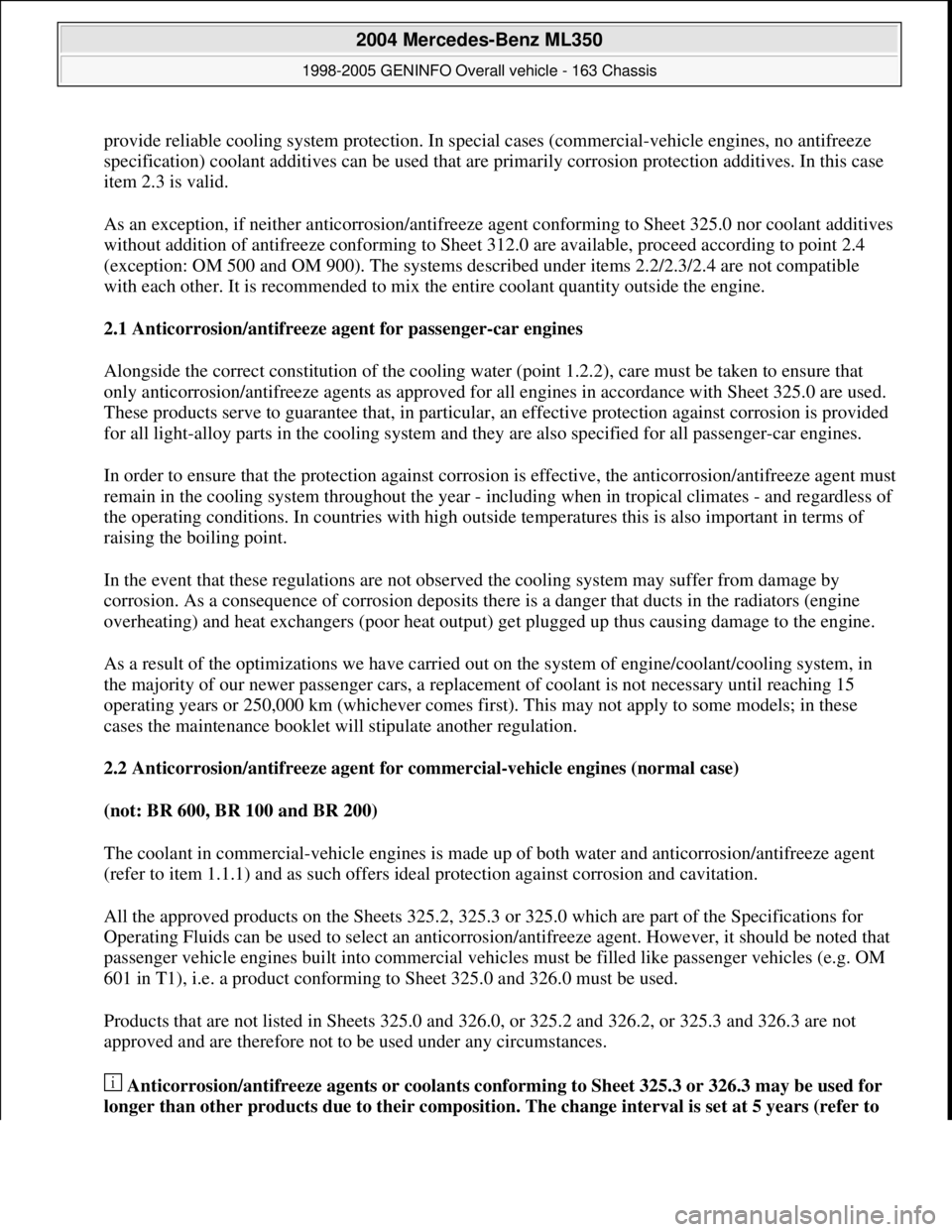
provide reliable cooling system protection. In special cases (commercial-vehicle engines, no antifreeze
specification) coolant additives can be used that are primarily corrosion protection additives. In this case
item 2.3 is valid.
As an exception, if neither anticorrosion/antifreeze agent conforming to Sheet 325.0 nor coolant additives
without addition of antifreeze conforming to Sheet 312.0 are available, proceed according to point 2.4
(exception: OM 500 and OM 900). The systems described under items 2.2/2.3/2.4 are not compatible
with each other. It is recommended to mix the entire coolant quantity outside the engine.
2.1 Anticorrosion/antifreeze agent for passenger-car engines
Alongside the correct constitution of the cooling water (point 1.2.2), care must be taken to ensure that
only anticorrosion/antifreeze agents as approved for all engines in accordance with Sheet 325.0 are used.
These products serve to guarantee that, in particular, an effective protection against corrosion is provided
for all light-alloy parts in the cooling system and they are also specified for all passenger-car engines.
In order to ensure that the protection against corrosion is effective, the anticorrosion/antifreeze agent must
remain in the cooling system throughout the year - including when in tropical climates - and regardless of
the operating conditions. In countries with high outside temperatures this is also important in terms of
raising the boiling point.
In the event that these regulations are not observed the cooling system may suffer from damage by
corrosion. As a consequence of corrosion deposits there is a danger that ducts in the radiators (engine
overheating) and heat exchangers (poor heat output) get plugged up thus causing damage to the engine.
As a result of the optimizations we have carried out on the system of engine/coolant/cooling system, in
the majority of our newer passenger cars, a replacement of coolant is not necessary until reaching 15
operating years or 250,000 km (whichever comes first). This may not apply to some models; in these
cases the maintenance booklet will stipulate another regulation.
2.2 Anticorrosion/antifreeze agent for commercial-vehicle engines (normal case)
(not: BR 600, BR 100 and BR 200)
The coolant in commercial-vehicle engines is made up of both water and anticorrosion/antifreeze agent
(refer to item 1.1.1) and as such offers ideal protection against corrosion and cavitation.
All the approved products on the Sheets 325.2, 325.3 or 325.0 which are part of the Specifications for
Operating Fluids can be used to select an anticorrosion/antifreeze agent. However, it should be noted that
passenger vehicle engines built into commercial vehicles must be filled like passenger vehicles (e.g. OM
601 in T1), i.e. a product conforming to Sheet 325.0 and 326.0 must be used.
Products that are not listed in Sheets 325.0 and 326.0, or 325.2 and 326.2, or 325.3 and 326.3 are not
approved and are therefore not to be used under any circumstances.
Anticorrosion/antifreeze agents or coolants conforming to Sheet 325.3 or 326.3 may be used for
longer than other products due to their composition. The change interval is set at 5 years (refer to
2004 Mercedes-Benz ML350
1998-2005 GENINFO Overall vehicle - 163 Chassis
me
Saturday, October 02, 2010 3:47:57 PMPage 524 © 2006 Mitchell Repair Information Company, LLC.
Page 3170 of 4133
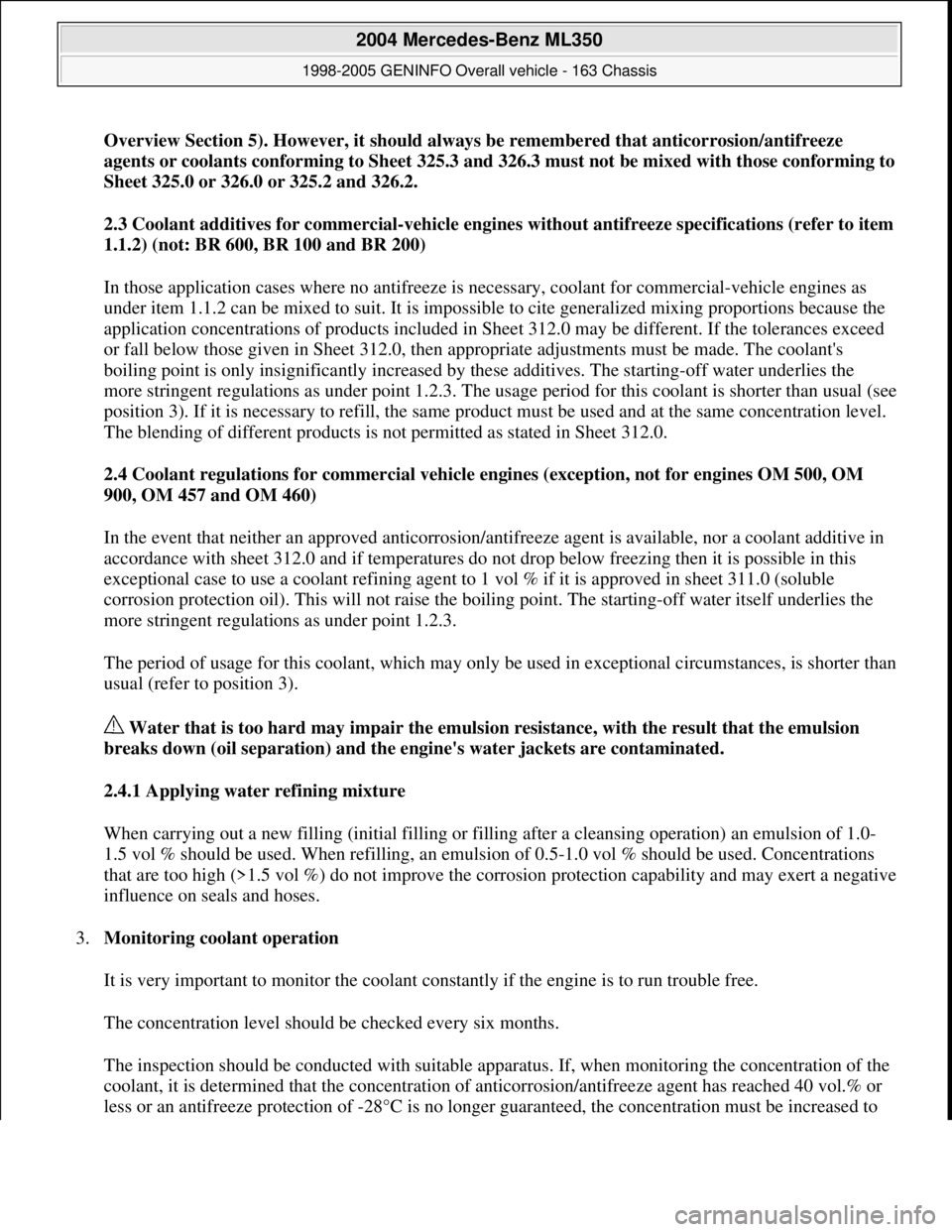
Overview Section 5). However, it should always be remembered that anticorrosion/antifreeze
a
gents or coolants conforming to Sheet 325.3 and 326.3 must not be mixed with those conforming to
Sheet 325.0 or 326.0 or 325.2 and 326.2.
2.3 Coolant additives for commercial-vehicle en
gines without antifreeze specifications (refer to item
1.1.2) (not: BR 600, BR 100 and BR 200)
In those application cases where no antifreeze is necessary, coolant for commercial-vehicle engines as
under item 1.1.2 can be mixed to suit. It is impossible to cite generalized mixing proportions because the
application concentrations of products included in Sheet 312.0 may be different. If the tolerances exceed
or fall below those given in Sheet 312.0, then appropriate adjustments must be made. The coolant's
boiling point is only insignificantly increased by these additives. The starting-off water underlies the
more stringent regulations as under point 1.2.3. The usage period for this coolant is shorter than usual (see
position 3). If it is necessary to refill, the same product must be used and at the same concentration level.
The blending of different products is not permitted as stated in Sheet 312.0.
2.4 Coolant regulations for commercial vehicle engines (exception, not for engines OM 500, OM
900, OM 457 and OM 460)
In the event that neither an approved anticorrosion/antifreeze agent is available, nor a coolant additive in
accordance with sheet 312.0 and if temperatures do not drop below freezing then it is possible in this
exceptional case to use a coolant refining agent to 1 vol % if it is approved in sheet 311.0 (soluble
corrosion protection oil). This will not raise the boiling point. The starting-off water itself underlies the
more stringent regulations as under point 1.2.3.
The period of usage for this coolant, which may only be used in exceptional circumstances, is shorter than
usual (refer to position 3).
Water that is too hard may impair the emulsion resistance, with the result that the emulsion
breaks down (oil separation) and the engine's water jackets are contaminated.
2.4.1 Applying water refining mixture
When carrying out a new filling (initial filling or filling after a cleansing operation) an emulsion of 1.0-
1.5 vol % should be used. When refilling, an emulsion of 0.5-1.0 vol % should be used. Concentrations
that are too high (>1.5 vol %) do not improve the corrosion protection capability and may exert a negative
influence on seals and hoses.
3.Monitoring coolant operation
It is very important to monitor the coolant constantly if the engine is to run trouble free.
The concentration level should be checked every six months.
The inspection should be conducted with suitable apparatus. If, when monitoring the concentration of the
coolant, it is determined that the concentration of anticorrosion/antifreeze agent has reached 40 vol.% or
less or an antifreeze protection of -28°C is no lon
ger guaranteed, the concentration must be increased to
2004 Mercedes-Benz ML350
1998-2005 GENINFO Overall vehicle - 163 Chassis
me
Saturday, October 02, 2010 3:47:57 PMPage 525 © 2006 Mitchell Repair Information Company, LLC.
Page 3173 of 4133
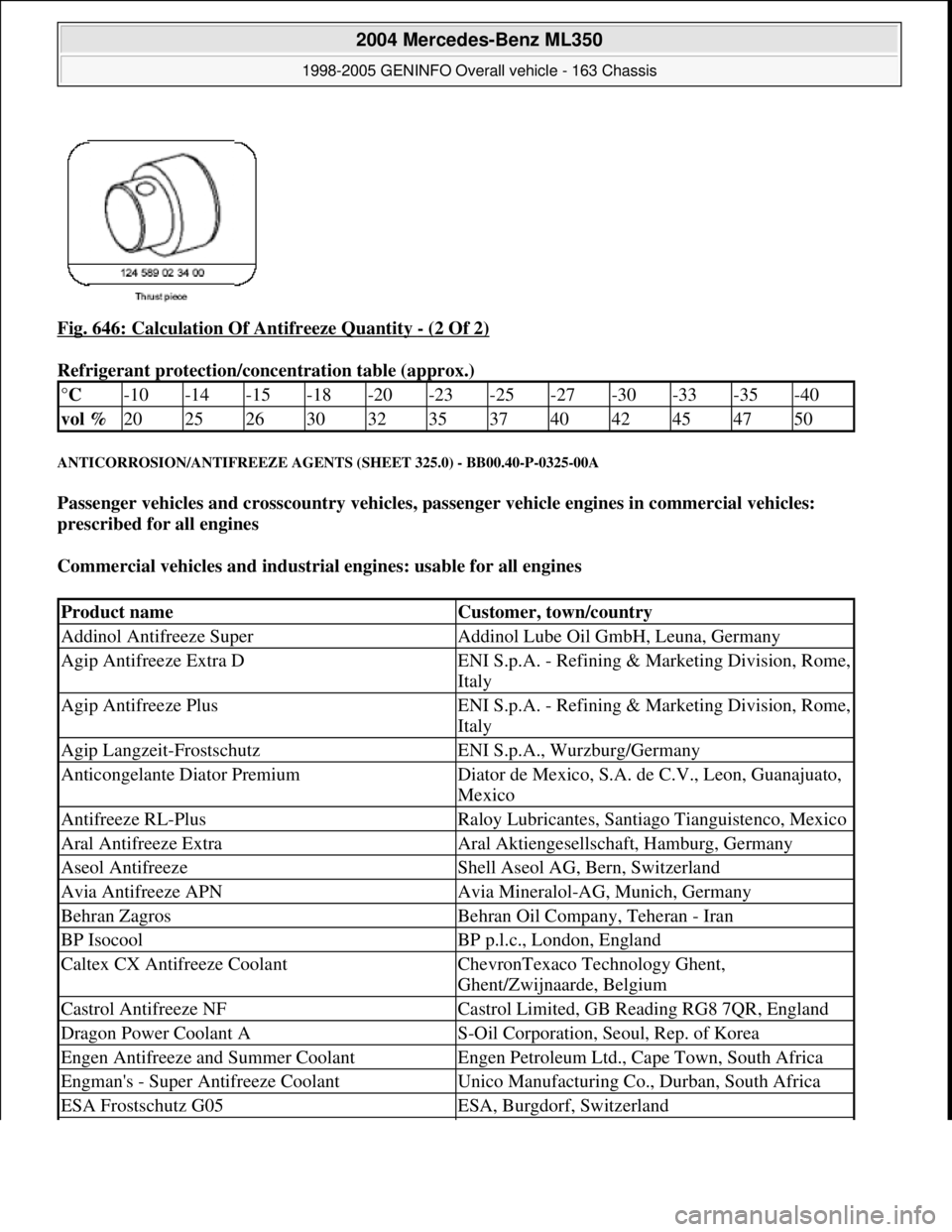
Fig. 646: Calculation Of Antifreeze Quantity - (2 Of 2)
Refrigerant protection/concentration table (approx.)
ANTICORROSION/ANTIFREEZE AGENTS (SHEET 325.0) - BB00.40-P-0325-00A
Passenger vehicles and crosscountry vehicles, passenger vehicle engines in commercial vehicles:
prescribed for all engines
Commercial vehicles and industrial engines: usable for all engines
°C -10-14-15-18-20-23-25-27-30-33-35-40
vol % 202526303235374042454750
Product nameCustomer, town/country
Addinol Antifreeze SuperAddinol Lube Oil GmbH, Leuna, Germany
Agip Antifreeze Extra DENI S.p.A. - Refining & Marketing Division, Rome,
Italy
Agip Antifreeze PlusENI S.p.A. - Refining & Marketing Division, Rome,
Italy
Agip Langzeit-FrostschutzENI S.p.A., Wurzburg/Germany
Anticongelante Diator PremiumDiator de Mexico, S.A. de C.V., Leon, Guanajuato,
Mexico
Antifreeze RL-PlusRaloy Lubricantes, Santiago Tianguistenco, Mexico
Aral Antifreeze ExtraAral Aktiengesellschaft, Hamburg, Germany
Aseol AntifreezeShell Aseol AG, Bern, Switzerland
Avia Antifreeze APNAvia Mineralol-AG, Munich, Germany
Behran ZagrosBehran Oil Company, Teheran - Iran
BP IsocoolBP p.l.c., London, England
Caltex CX Antifreeze CoolantChevronTexaco Technology Ghent,
Ghent/Zwijnaarde, Belgium
Castrol Antifreeze NFCastrol Limited, GB Reading RG8 7QR, England
Dragon Power Coolant AS-Oil Corporation, Seoul, Rep. of Korea
Engen Antifreeze and Summer CoolantEngen Petroleum Ltd., Cape Town, South Africa
Engman's - Super Antifreeze CoolantUnico Manufacturing Co., Durban, South Africa
ESA Frostschutz G05ESA, Burgdorf, Switzerland
2004 Mercedes-Benz ML350
1998-2005 GENINFO Overall vehicle - 163 Chassis
me
Saturday, October 02, 2010 3:47:57 PMPage 528 © 2006 Mitchell Repair Information Company, LLC.
Page 3174 of 4133

ESA Antifreeze G48ESA, Burgdorf, Switzerland
Eurol AfrostinEurol Produktionsges.m.b.H, Ried im Innkreis,
Austria
EuroPeak Coolant/AntifreezeOld World Industries, Inc., Northbrook, IL 60062,
USA
EVOX Extra G48 Antifreeze concentrateMOL-LUB Ltd., Almasfuzito, Hungary
Fridex G 48Velvana, a.s., Velvary, Czech Republic
Fuchs Fricofin antifreezeFuchs Petrolub AG, Mannheim, Germany
Genantin SuperClariant GmbH, Frankfurt/Main. Germany
Glacelf MDXTotal Lubrifiants, Paris la Defense Cedex, France
GlycoShellShell International Petroleum Co., London, England
GlycoShell NShell International Petroleum Co., London, England
Glysantin Anti KorrosionBASF AG, Ludwigshafen. Germany
Glysantin G 48BASF AG, Ludwigshafen. Germany
Glysantin mit Protect PlusBASF AG, Ludwigshafen. Germany
Hightec Antifreeze ANROWE Mineralolwerk GmbH, Bubenheim,
Germany
INA Antifriz Al SuperMaziva - Zagreb d.o.o., Zagreb/Croatia
Krafft Refrigerant ACU 2300Krafft S.A., Andoain (Guipuzcoa), Spain
MB 325.0 anticorrosion/ antifreeze agents 000 989
08 25DaimlerChrysler AG, Stuttgart, Germany
MB 325.0 anticorrosion/antifreeze agent 000 989 21
25DaimlerChrysler AG, Stuttgart, Germany
Mobil GS 333 ExtraExxon Mobil Corporation, Fairfax, Virginia, USA
Motorex Antifreeze G05Bucher AG Langenthal, Langenthal/Switzerland
Motorex Antifreeze Protect G48Bucher AG Langenthal, Langenthal/Switzerland
OMV KuhlerfrostschutzOMV Refining & Marketing GmbH, Vienna,
Austria
Panolin Anti-Frost MT-325Panolin AG, Madetswil, Switzerland
Permant 100Oil Refinery Modrica, Modrica, Bosnia-
Herzegovina
PO ozel AntifrizPetrol Ofisi Anonim Sirketi, Istanbul, Turkey
Powercooling Concentrate AntifreezeSMB, Passy, France
Procar Kuhlerschutz ExtraHunold Schmierstoffe GmbH, Eching, Germany
Sasol FreezolSasol Oil (Pty) Ltd, Randburg, South Africa
Shell Tri GuardShell South Africa, Cape Town, South Africa
Total Antifreeze and Summer CoolantTotal Lubrifiants, Paris la Defense Cedex, France
Valvoline AntiFreeze ExtraThe Valvoline Company, Lexington, KY/USA
York 716Ginouves Georges S.A., La Farleade, France
Zerex G 05The Valvoline Company, Lexington, KY/USA
Zerex G 48The Valvoline Company, Lexington, KY/USA
2004 Mercedes-Benz ML350
1998-2005 GENINFO Overall vehicle - 163 Chassis
me
Saturday, October 02, 2010 3:47:57 PMPage 529 © 2006 Mitchell Repair Information Company, LLC.
Page 3175 of 4133
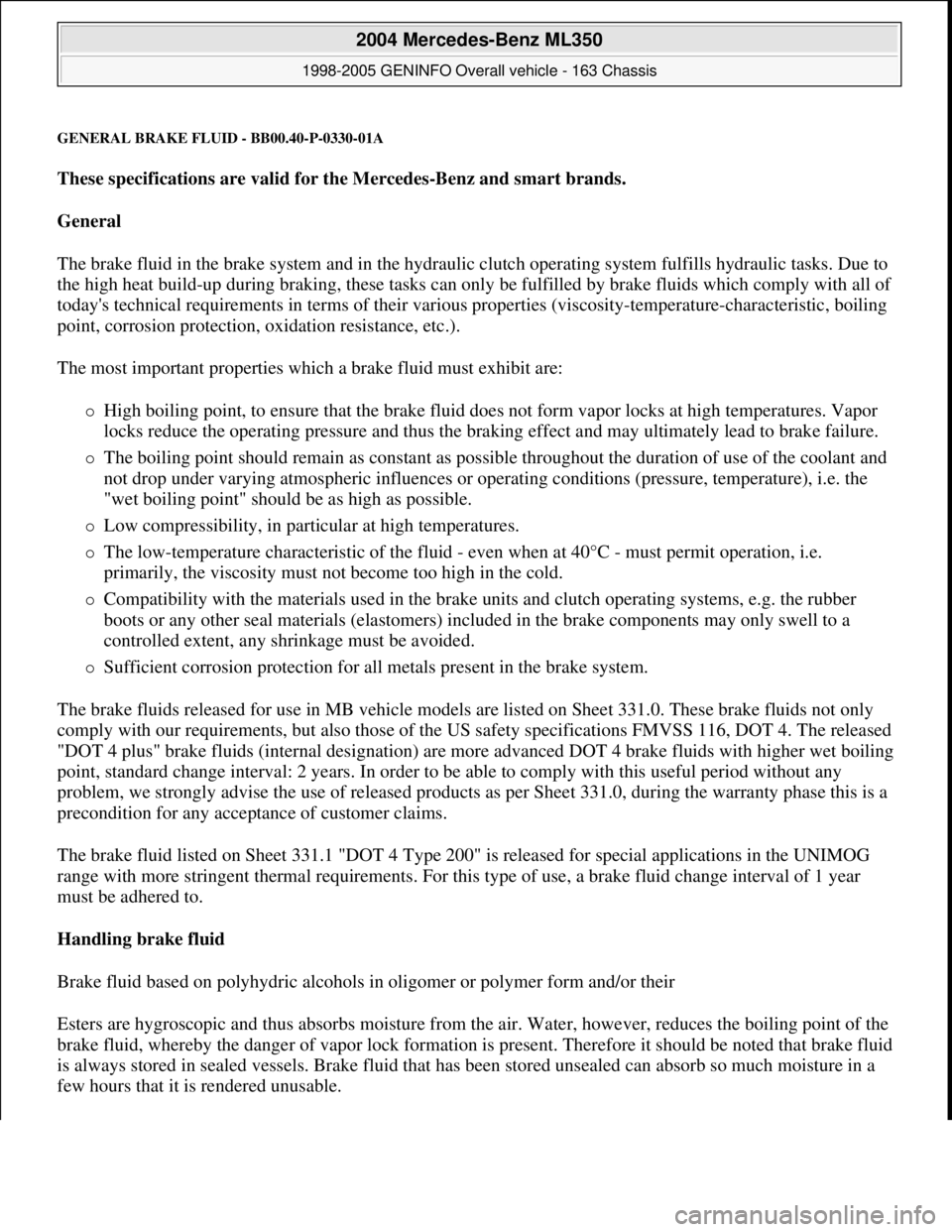
GENERAL BRAKE FLUID - BB00.40-P-0330-01A
These specifications are valid for the Mercedes-Benz and smart brands.
General
The brake fluid in the brake system and in the hydraulic clutch operating system fulfills hydraulic tasks. Due to
the high heat build-up during braking, these tasks can only be fulfilled by brake fluids which comply with all of
today's technical requirements in terms of their various properties (viscosity-temperature-characteristic, boiling
point, corrosion protection, oxidation resistance, etc.).
The most important properties which a brake fluid must exhibit are:
High boiling point, to ensure that the brake fluid does not form vapor locks at high temperatures. Vapor
locks reduce the operating pressure and thus the braking effect and may ultimately lead to brake failure.
The boiling point should remain as constant as possible throughout the duration of use of the coolant and
not drop under varying atmospheric influences or operating conditions (pressure, temperature), i.e. the
"wet boiling point" should be as high as possible.
Low compressibility, in particular at high temperatures.
The low-temperature characteristic of the fluid - even when at 40°C - must permit operation, i.e.
primarily, the viscosity must not become too high in the cold.
Compatibility with the materials used in the brake units and clutch operating systems, e.g. the rubber
boots or any other seal materials (elastomers) included in the brake components may only swell to a
controlled extent, any shrinkage must be avoided.
Sufficient corrosion protection for all metals present in the brake system.
The brake fluids released for use in MB vehicle models are listed on Sheet 331.0. These brake fluids not only
comply with our requirements, but also those of the US safety specifications FMVSS 116, DOT 4. The released
"DOT 4 plus" brake fluids (internal designation) are more advanced DOT 4 brake fluids with higher wet boiling
point, standard change interval: 2 years. In order to be able to comply with this useful period without any
problem, we strongly advise the use of released products as per Sheet 331.0, during the warranty phase this is a
precondition for any acceptance of customer claims.
The brake fluid listed on Sheet 331.1 "DOT 4 Type 200" is released for special applications in the UNIMOG
range with more stringent thermal requirements. For this type of use, a brake fluid change interval of 1 year
must be adhered to.
Handling brake fluid
Brake fluid based on polyhydric alcohols in oligomer or polymer form and/or their
Esters are hygroscopic and thus absorbs moisture from the air. Water, however, reduces the boiling point of the
brake fluid, whereby the danger of vapor lock formation is present. Therefore it should be noted that brake fluid
is always stored in sealed vessels. Brake fluid that has been stored unsealed can absorb so much moisture in a
few hours that it is rendered unusable.
2004 Mercedes-Benz ML350
1998-2005 GENINFO Overall vehicle - 163 Chassis
me
Saturday, October 02, 2010 3:47:57 PMPage 530 © 2006 Mitchell Repair Information Company, LLC.
Page 3176 of 4133

Because the brake fluid also absorbs moisture through the vent bore on the expansion reservoir, the wheel brake
cylinder and the brake hoses, the brake fluid has to be changed for safety reasons at regular intervals, best done
in the spring. When performing this change, make sure that the old fluid is also drained off the clutch system.
Generally, it is vital for the brake/clutch system to be completely drained before being filled with new fluid!
For the above-mentioned reasons, used brake fluid must not be used again.
The brake fluid is amber in color and thus can be easily confused with mineral products.
Therefore, brake fluids should always only be taken from original containers and stored separately from other
mineral oils and fluids.
When performing maintenance operations and repairs on brake parts, make sure that fuel, mineral oil, grease or
suchlike do not enter the brake system. Hydrocarbon-based materials will lead to swelling of the elastomers in
the brake and clutch system and - even in low concentrations - will suffice to cause total failure of the systems.
Only new brake fluid may be used as a rinsing and cleaning agent for the cylinders, lines and the expansion
reservoir of the hydraulic brake system.
Experience shows that before handling brake fluid, the hands must be cleaned and any oil and grease removed.
Brake fluid acts aggressively towards paint and color. In the event of any brake fluid spills or splashes, it must
be rinsed away immediately using copious amounts of water (do not rub it away).
Brake fluid disposal
When disposing of brake fluid, the relevant national specifications must be observed. It is advisable to try to
have the brake fluid disposed of as economic good; this is contingent on
Strict separation of used brake fluid from other materials;
Presence of a disposal channel, which justifies its classification as an economic good, i.e. a proper
alternate usage must be assured.
If this procedure is not possible, used brake fluid is to be disposed of together with any, e.g. paint residue,
solvents and suchlike. Any adding of used oil must be avoided, as it will result in difficulties, if the used oil is to
be recycled; in several countries this is prohibited by the legislators.
MISCELLANEOUS NOTES
NOTES ON SCRAPPING GAS-FILLED HYDRAULIC COMPONENTS - OS00.00-P-1000-01A
all
Unusable gas pressure dampers, spring accumulators, pressure reservoirs and impact absorbers have to be
depressurized before being scrapped according to the respective valid accident prevention regulations. These
safety measures are necessary because gas pressurized hydraulic parts can explode if heat is applied. A risk of
explosion is
given, e.g. when scrapping with cutting torches, smelting or if gas pressurized parts in landfills start
2004 Mercedes-Benz ML350
1998-2005 GENINFO Overall vehicle - 163 Chassis
me
Saturday, October 02, 2010 3:47:57 PMPage 531 © 2006 Mitchell Repair Information Company, LLC.
Page 3177 of 4133
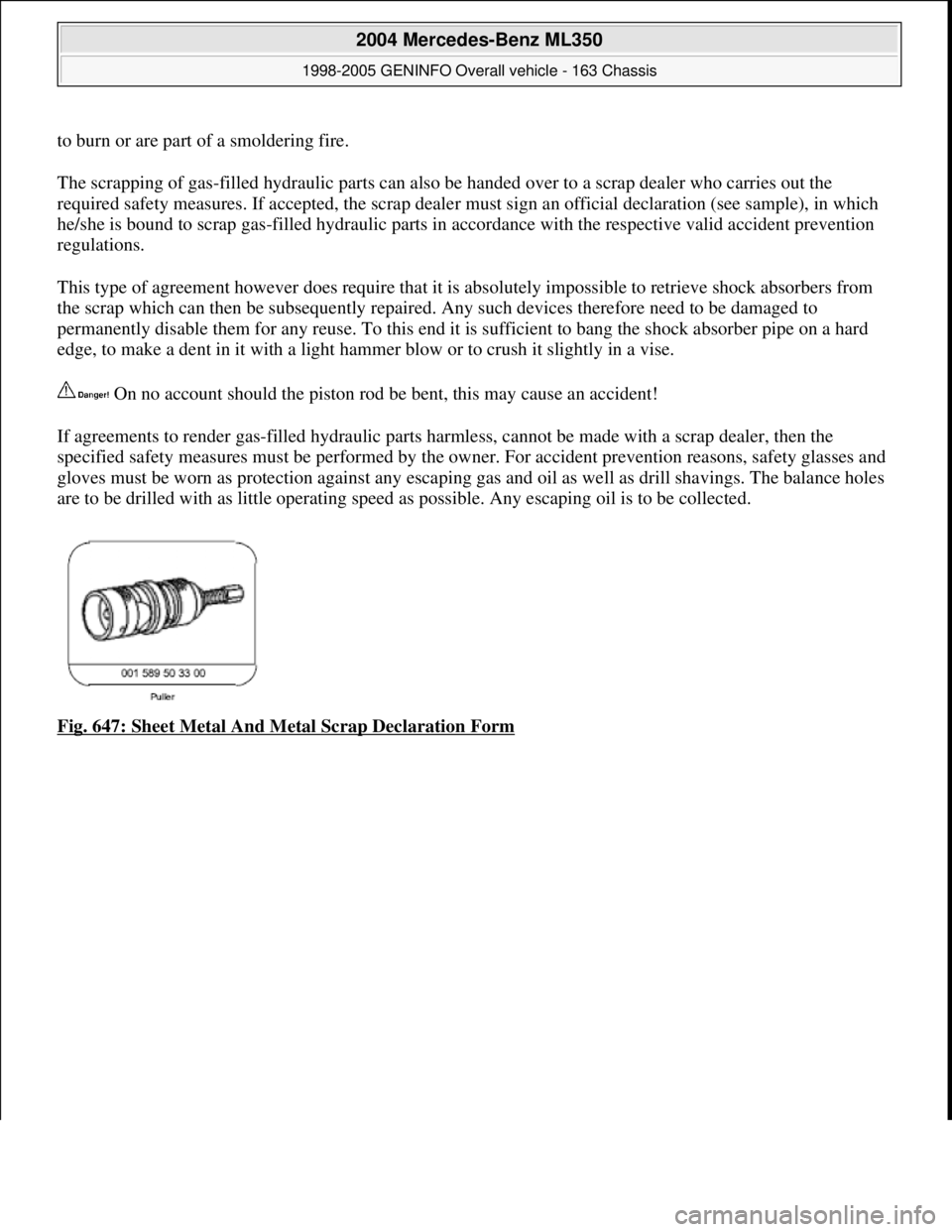
to burn or are part of a smoldering fire.
The scrapping of gas-filled hydraulic parts can also be handed over to a scrap dealer who carries out the
required safety measures. If accepted, the scrap dealer must sign an official declaration (see sample), in which
he/she is bound to scrap gas-filled hydraulic parts in accordance with the respective valid accident prevention
regulations.
This type of agreement however does require that it is absolutely impossible to retrieve shock absorbers from
the scrap which can then be subsequently repaired. Any such devices therefore need to be damaged to
permanently disable them for any reuse. To this end it is sufficient to bang the shock absorber pipe on a hard
edge, to make a dent in it with a light hammer blow or to crush it slightly in a vise.
On no account should the piston rod be bent, this may cause an accident!
If agreements to render gas-filled hydraulic parts harmless, cannot be made with a scrap dealer, then the
specified safety measures must be performed by the owner. For accident prevention reasons, safety glasses and
gloves must be worn as protection against any escaping gas and oil as well as drill shavings. The balance holes
are to be drilled with as little operating speed as possible. Any escaping oil is to be collected.
Fig. 647: Sheet Metal And Metal Scrap Declaration Form
2004 Mercedes-Benz ML350
1998-2005 GENINFO Overall vehicle - 163 Chassis
me
Saturday, October 02, 2010 3:47:57 PMPage 532 © 2006 Mitchell Repair Information Company, LLC.